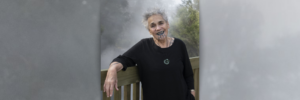
Jessica Hansell (Ngāpuhi, Samoa) is a writer, multimedia artist and musician from Auckland, long known by her rap nickname Coco Solid. She is the creator of cult Maori cartoon Aroha Bridge with a vast range of screenwriting credits. She was named the Fulbright Creative New Zealand Pacific writer in residence in 2018, studying at the University of Hawai’i, where she started writing her ground-shaking, best-selling pukapuka How To Loiter In A Turf War.
Congratulations on the resounding applause for your incredible multi-genre pukapuka, How to Loiter In a Turf War. How has the journey been since your book was launched into te ao mārama?
I’m having a beautiful time with my book being out in the world which is cool. I very openly dissed the creepy inequities in local literature and it’s cool to transcend that conversation by just doing my thing/proving my point. Everything about the timing of ‘How To Loiter In A Turf War’ has felt very hard-earned but weirdly ordained, very spiritually timed and how it had to be. I’ve learned how generous people in the bookselling space are to writers. I’ve seen my supposedly niche audience show out big time and put the book in a position I never saw coming. Most of all I relish the very intense readings I’ve received about the work itself, the critical love my people have shown me. In many ways it’s a hard act for my other projects to follow. It’s been a massive experience.
How to Loiter In a Turf War was described by one reviewer as both skux and scholarly, and your writing interweaves anger, loss, humour and tenderness so effortlessly. How do you ensure you achieve the perfect balance?
I don’t know if I ever do achieve the perfect balance, I just know how to describe imbalance well and make it loveable. That’s my life. If you don’t have the hacks, codes or range you don’t really survive out here. So people have double, triple lives and I’m no exception. It’s always been drip or drown in my world, so I really wanted to characterise and depict that in the book. Our multitudes aren’t always a fun little flourish or choice, they’re literally evolutionary tactics. We hold these traits, ideas, traumas, stories, ambitions – they clash and chaffe but we heave them around, we keep it moving. We are really that high end and that low brow. Passive observer and reactive eruption. I think what I enjoyed about writing this book was my refusal for these girls to ‘pick a side’ and be clean little depictions. That’s just not possible, that’s not real. The accuracy that resonated with a lot of readers was the wild amount of compromising we have to do. The way we shapeshift to meet the situation without thinking.
In addition to being a writer, you’re also a well-respected musician. What music influenced you while writing this book?
I actually have a Spotify playlist called ‘How to Loiter In A Turf War The Motion Picture Soundtrack’ which is pretty crack up. I’ve got a song energetically matched for each chapter. When I was releasing the book I asked people online what they wanted from me ‘build the hype’ wise and a musical accompaniment came up a few times. So I made one for the audio visual girlies.
Sometimes writers talk about their book as if it is something they’ve birthed – a struggle as well as a gift. If you were to think of your book this way, who are its whanaunga?
I think it’s a direct retaliation against the classist literary canon I’ve experienced for years as a writer – my antithesis whanaunga. I’m not twee, I’m not always palatable, I’m not white girl wacky, I’m not brown girl lost, I’m not a good keen man. So it stands to reason I don’t romanticise the brutality this country was built on. I think the work nods to very experimental Māori Pasifika artists I love and the punk ephemera/ social justice ideals of the Aotearoa DIY underground arts. That’s where I’m happiest, not in literature. I want the book to dissatisfy and disorient people attached to the grand old tradition of the ‘classic kiwi novel’ and what that’s allowed to look and feel like. I think it’s closely tied to the mediums that it tries to replicate within the book. Indigenous activism and academic essays, zines, comics, murals, visual storytelling. I wanted that feeling when a friend lets you look at their work – their sketchbook, their notes app, their uni essay they left in the lounge. I wanted to honour the poems that never quite got to see the light of day because the person got gaslit out of writing. That was very nearly me.
What do you think your tīpuna think of this book? What would their reactions be?
I think my honourable ancestors dig it hard. They’re proud and understand what I’m trying to do. I think they kept me here to complete it in a lot of ways. My dishonourable ancestors are probably beefing about it but that’s curse breaking for you. I think my takataapui ancestors are appeased and exalted, especially one in particular. I think the difficult women in my bloodline who tussled and created without credit will feel some type of way. I think my tupuna who actively refused to cede sovereignty would love the intent, but are probably eye rolling at my soft hands a little bit.
What advice do you have for emerging Māori writers?
Apart from “strap in bitch” I probably wouldn’t prescribe one piece of advice to such a volatile and complex group. No advice from a writer could have prepared me for what I had to go through in order to complete my book, so I’d rather just encourage next level resilience. There’s lots of hints about what I think about writing within the book itself and it’s not always flattering.
My first exposure to How to Loiter In a Turf War was through listening to your audiobook. I was thrilled and surprised to find it on Audible and thankful that you narrate it. What was that process like and what are your whakaaro on audiobooks by Māori writers?
The audiobook was pretty hard because my text-writing and my oratory-writing are two completely different brains. I also found that when you’re saying the heavier words, they pass through your body and it feels like you’re processing those difficult chapters all over again. I did relish being able to depict things with the exact cadence and tune that was in my head, especially with dialogue and slang because how me and my girls speak is so specific. And I love that the feedback to the audiobook has been just as intense as the text. I love that three new Mums had babies at their breast and were fighting off cackles in the dark. People with reading accessibility issues have thanked me, as have listeners who don’t hear my particular strain of New Zealand accent often in the audiobook space. I like role modelling that people who look and sound like them are allowed in there.
What projects are you working on now or hope to be working on in the future?
Running our space Wheke Fortress, keeping up with all the creatives and different kaupapa hurtling through here. Trying to finish off my damn TV show that the book completely ended up eclipsing, getting our record label Kuini Qontrol ready for new music. I’ve got one final literary event to do in Pōneke this November and then I’m off the circuit for a bit. The best project for me this summer will be going up North and having a break.




